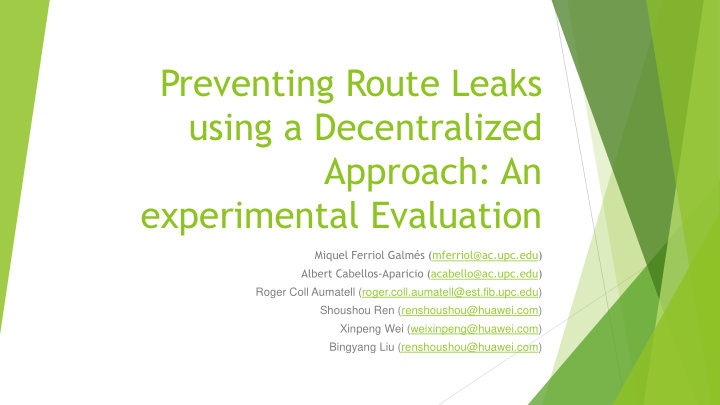



Preventing Route Leaks using a Decentralized Approach: An experimental Evaluation Miquel Ferriol Galmés (mferriol@ac.upc.edu) Albert Cabellos-Aparicio (acabello@ac.upc.edu) Roger Coll Aumatell (roger.coll.aumatell@est.fib.upc.edu) Shoushou Ren (renshoushou@huawei.com) Xinpeng Wei (weixinpeng@huawei.com) Bingyang Liu (renshoushou@huawei.com)
Context 2
Border Gateway Protocol (BGP) Routing protocol that glues the Internet Provides reachability and path selection 3
Border Gateway Protocol (BGP) Routing protocol that glues the Internet Provides reachability and path selection As the Internet and business-oriented Autonomous Systems(AS) began to provide connectivity, the different polices started to be: More complex More rich More fine-grained 4
Example Peer - Peer AS1 AS2 5
Example Peer - Peer Customer - Provider BGP Update AS1 AS2 6
Example AS3 Peer - Peer Customer - Provider BGP Update AS1 AS2 7
Example BGP is based on trust This protocol is vulnerable to a different number of security threads An important BGP security threat are Route Leaks 8
Route Leaks 9
Route Leaks Route leaks occur when one AS violates the routing policies agreed with another AS This policies are based according to the business relationship between them This violations can lead to: Traffic redirection, traffic loss, traffic hijacking, prefix blackholding … 10
Route Leaks AS701 AS396531 AS33154 AS link Original route of the traffic Traffic after route leak BGP Update 11
Route Leaks Route leaks are a simple problem but hard to fix: BGP protocol lacks of cryptographic-based security mechanisms Inter-domain routing lacks a standard mechanism to communicate routing policy 12
BGP Communities Transitive attribute attached to BGP messages Used for tagging routes and for modifying BGP routing decisions Can be added , removed , or modified as the message travels from AS to AS Represent an important attack vector 13
Proposed Solution
Architecture Take advantage of BGP communities to address the challenges of route leaks Propose an architecture that provides a formal definition of routing policy Secure mechanism to communicate it to participating ASes ( Block-chain based ) 15
Formal language Contains 5 parameters: ASN : AS number CN : Community number Rule : The policy to be applied (e.g., LOCALPREFERENCE, PREPEND…) Value (optional) : It normally defines the quantity of a given effect. To: what the rule refers to.
Distributed ledger Set of requirements: Authentication Permissioned Privacy and confidentiality
How the policies are uploaded to the Distributed Ledger? Execute a transaction and verify its correctness Order transactions via a consensus protocol Validate a transaction against a specific endorsement policy before committing them to the ledger
Architecture 19
Architecture 20
Architecture 21
Experimental Evaluation 22
Prototyping the Distributed Ledger 23
How scalable is the ledger? Variable 1 Variable 2 Relationship Chain size Number of communities Linear Time to add a new community Number of endorsers Linear Compiling time Number of communities Linear 24
Preventing Route Leaks in a Realistic Topology 25
Dataset 27 Ases 458 BGP Communities Transformed to the formal language 26
Real Topology 27
Experimental Results 28
Conclusions Open-source [1] prototype of a blockchain-based solution to prevent route leaks Scales linearly with respect to relevant metrics and that introduces negligible delay Prototype in a real-world scenario by preventing a route-leak in a 10 ASes topology [1] https://github.com/MiquelFerriol/SecuringBGP 29
Thank you for watching
Recommend
More recommend